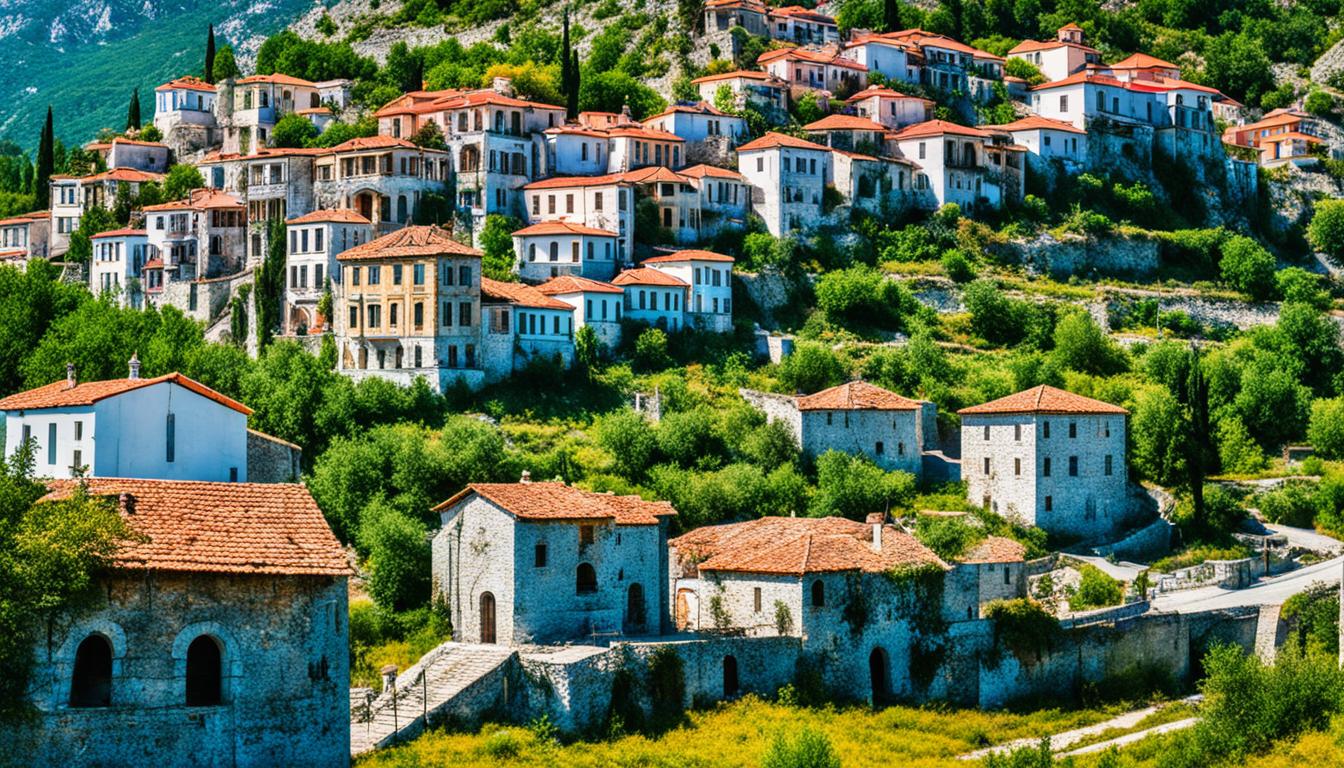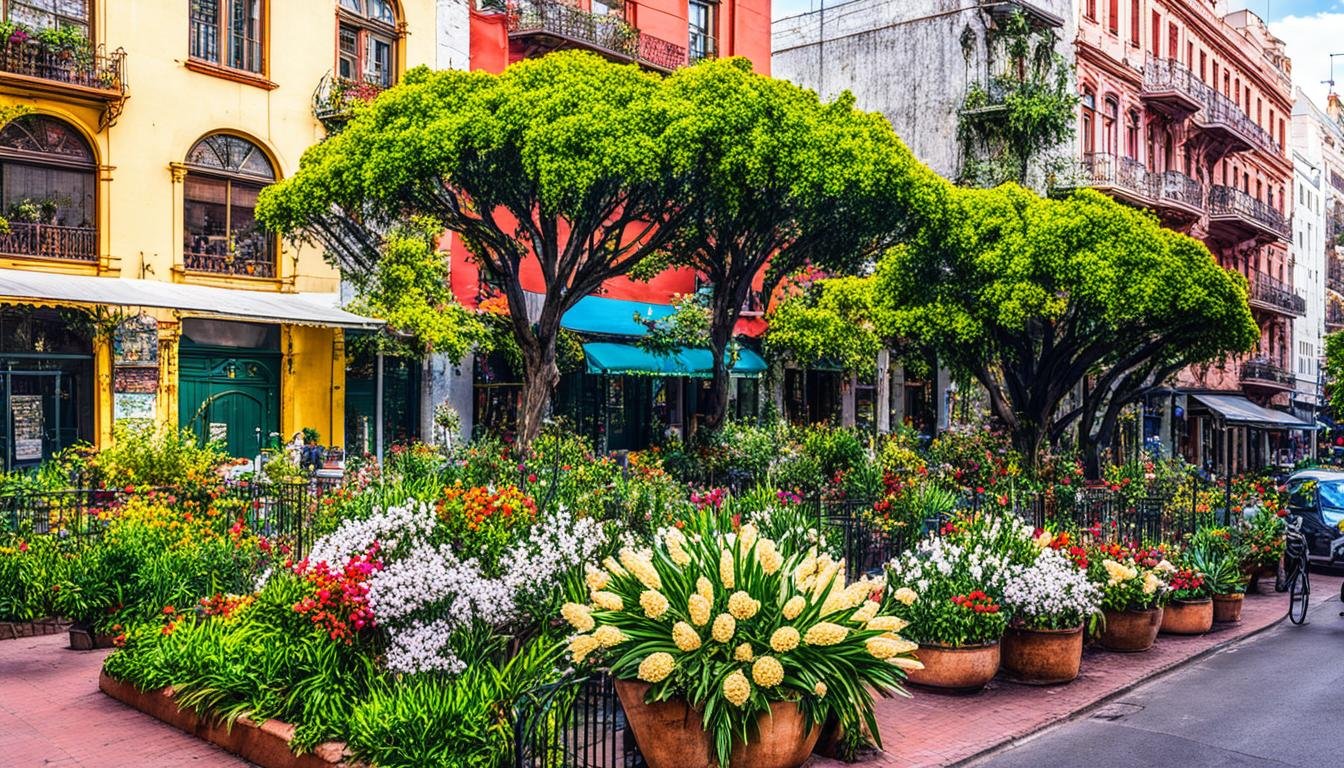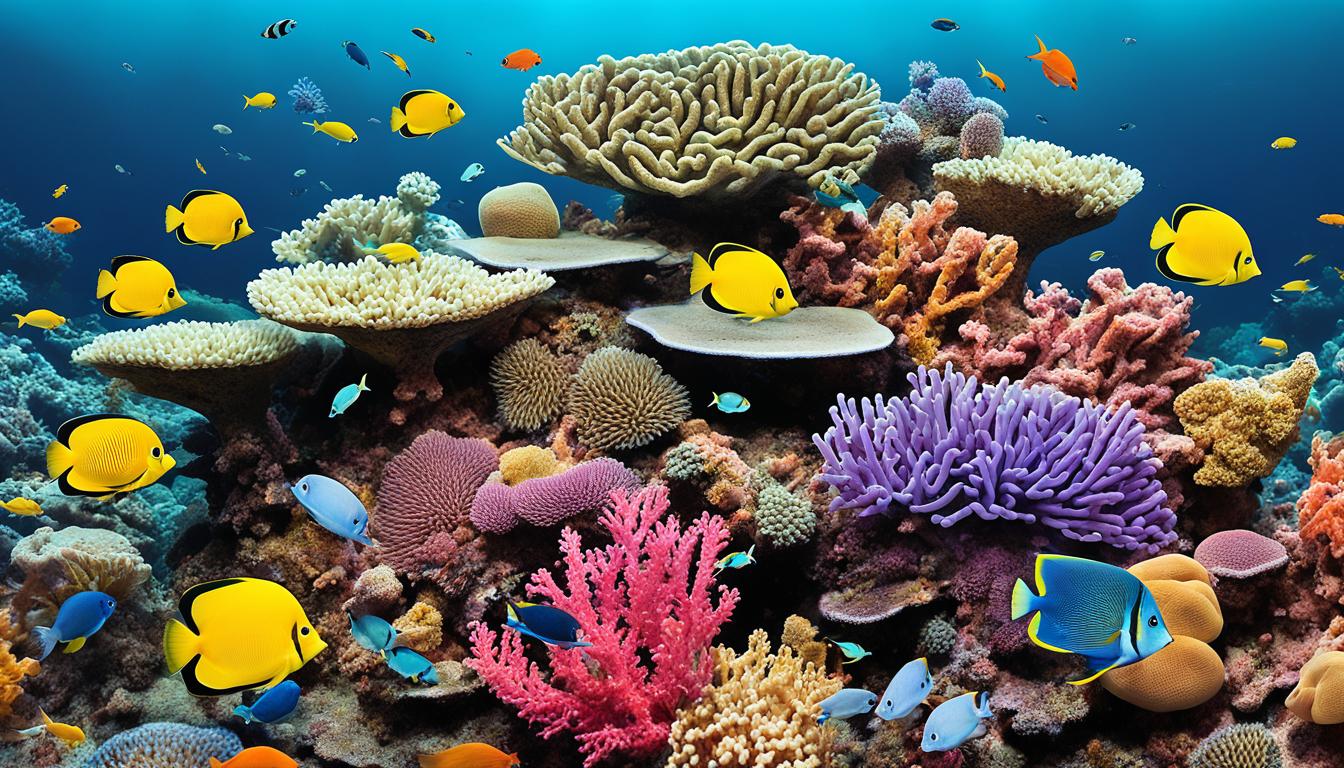Antigua and Barbuda Biodiversity and the Built Environment
Antigua and Barbuda, located in the Caribbean Sea, boasts a unique blend of stunning natural beauty and a rich diversity of plant and animal species. However, this biodiversity faces threats from human activities and the changing climate. In this article, we will delve into the enchanting flora and fauna of Antigua and Barbuda and explore the challenges it confronts.
Conserving biodiversity is crucial for achieving sustainable development and safeguarding ecosystem services that benefit both humans and the environment. Antigua and Barbuda recognizes the importance of environmental planning and embraces concepts such as green infrastructure and habitat restoration to protect its natural heritage. By promoting urban biodiversity and implementing climate resilience strategies, the country strives to ensure the long-term ecological and social resilience of its ecosystems.
Key Takeaways:
- Biodiversity conservation is vital for sustainable development and the preservation of ecosystem services.
- Antigua and Barbuda’s rich flora and fauna contribute to its unique ecological diversity.
- Preserving biodiversity benefits not only the environment but also the tourism industry and the economy.
- Conservation efforts by organizations and the government play a crucial role in protecting Antigua and Barbuda’s biodiversity.
- Sustainable development practices, including green infrastructure and environmental planning, are integral to building resilient communities in Antigua and Barbuda.
The Rich Flora and Fauna of Antigua and Barbuda
Antigua and Barbuda boast a rich and diverse range of plant and animal life. The islands are home to over 500 species of flowering plants and a variety of bird and marine life. The unique habitats in Antigua and Barbuda support a wide range of species, contributing to the region’s ecological diversity.
Antigua and Barbuda’s flora and fauna form an integral part of the country’s natural heritage. The islands’ lush landscapes are teeming with vibrant plant life, including mangroves, tropical rainforests, and coastal wetlands. These diverse habitats provide refuge for an array of animal species, from the endangered hawksbill sea turtle to the indigenous Antiguan racer snake.
The islands’ ecological diversity is further accentuated by the presence of endemic species found nowhere else in the world. For example, the Barbuda warbler, a small passerine bird, is unique to Barbuda and plays a crucial role in the island’s ecosystem. Other notable species include the Antiguan crested hummingbird, the common tenrec, and the Antigua black pineapple, a rare fruit indigenous to the island.
The marine environment surrounding Antigua and Barbuda is equally rich in biodiversity. The crystal-clear waters are home to an abundance of marine life, including coral reefs, seagrass beds, and mangroves. Numerous species of fish, turtles, and marine invertebrates inhabit these habitats, contributing to the overall ecological health and resilience of the region.
Preserving the flora and fauna of Antigua and Barbuda is of paramount importance. These unique habitats not only support a wide range of species but also offer numerous ecosystem services, such as air purification, water filtration, and climate regulation. Additionally, they play a vital role in attracting tourists, contributing to the islands’ economy. Protecting and conserving these natural treasures ensures a sustainable future for Antigua and Barbuda and safeguards its ecological heritage for generations to come.
Key Highlights:
- Over 500 species of flowering plants
- Diverse bird and marine life
- Unique habitats supporting endemic species
- Rich marine biodiversity
- Ecosystem services and economic contributions
| Plant Species | Animal Species |
|---|---|
| Barbuda warbler | Hawksbill sea turtle |
| Antigua black pineapple | Antiguan racer snake |
| Antiguan crested hummingbird | Common tenrec |
The Importance of Preserving Antigua and Barbuda’s Flora and Fauna
The flora and fauna in Antigua and Barbuda are of immense ecological value and play a vital role in the country’s economy. The remarkable diversity of natural habitats in the islands attracts tourists from around the world, contributing significantly to the thriving tourism industry. Conservation efforts are critical in safeguarding Antigua and Barbuda’s biodiversity and preserving its breathtaking landscapes.
Antigua and Barbuda’s biodiversity conservation efforts are essential for several reasons. Firstly, the region’s ecological value cannot be overstated. The unique combination of plant and animal species creates a delicate balance in the ecosystem, supporting important ecological processes and providing crucial ecosystem services. These services include pollination, nutrient cycling, and water purification, which are vital for maintaining a healthy environment.
“Preserving Antigua and Barbuda’s flora and fauna is not only about protecting individual species; it is about safeguarding the intricate web of life that sustains us all.”
Secondly, the economic contribution of Antigua and Barbuda’s biodiversity cannot be ignored. The tourism industry is heavily reliant on the stunning natural beauty of the islands, including their diverse wildlife. Visitors are drawn to the opportunity to explore the lush forests, pristine beaches, and vibrant coral reefs, all of which are home to a rich array of plant and animal species. The economic benefits derived from sustainable tourism can support local communities, create employment opportunities, and drive economic growth.
To truly appreciate the importance of Antigua and Barbuda’s biodiversity conservation, it is crucial to understand the significance of natural habitats. These habitats are the foundation of the diverse ecosystems found in the country. They include pristine beaches, mangrove forests, tropical rainforests, and marine environments such as coral reefs. Each habitat hosts a unique assemblage of species, contributing to the overall ecological diversity of the islands.
| Key Contributions of Antigua and Barbuda’s Biodiversity | Benefits |
|---|---|
| Attraction for tourists | Boosts the tourism industry and supports the local economy |
| Ecosystem services | Supports important ecological processes and provides benefits such as pollination and water purification |
| Preservation of unique species | Protects endemic and endangered species, contributing to global biodiversity conservation |
| Enhancement of natural landscapes | Ensures the beauty and integrity of the islands’ natural environments |
To ensure the continued preservation of Antigua and Barbuda’s flora and fauna, it is crucial to implement effective conservation strategies. These may include the establishment of protected areas, habitat restoration initiatives, sustainable land and resource management practices, and public awareness campaigns. By safeguarding the country’s natural heritage, Antigua and Barbuda can secure a sustainable future for both its biodiversity and its people.
Conservation Efforts in Antigua and Barbuda
Antigua and Barbuda is deeply committed to the preservation of its biodiversity. Various organizations and government agencies actively contribute to conservation initiatives, ensuring the protection and sustainable management of the region’s natural habitats.
Environmental Awareness Group
A prominent organization driving conservation efforts in Antigua and Barbuda is the Environmental Awareness Group (EAG). Founded in 1988, the EAG focuses on advocating for environmental protection and sustainable development. Through education, research, and community engagement, the EAG raises awareness about the importance of conservation and encourages individuals to play an active role in preserving the country’s biodiversity.
Antigua and Barbuda Marine Association
The Antigua and Barbuda Marine Association (ABMA) also plays a vital role in environmental conservation. This nonprofit organization works closely with local stakeholders to promote responsible marine practices and safeguard the marine environment. The ABMA actively supports initiatives such as coral reef restoration, marine debris cleanup, and sustainable fishing practices, ensuring the long-term health of Antigua and Barbuda’s coastal ecosystems.
The government of Antigua and Barbuda is actively involved in conservation efforts as well. The Antigua and Barbuda Department of Environment and National Parks Authority take the lead in managing and preserving protected areas within the country. Through rigorous monitoring, enforcement of regulations, and the implementation of sustainable management strategies, these government bodies ensure the preservation of vital habitats.
| Conservation Organizations | Mission |
|---|---|
| Environmental Awareness Group | Advocating for environmental protection and sustainable development through education and community engagement. |
| Antigua and Barbuda Marine Association | Promoting responsible marine practices, supporting coral reef restoration, and implementing sustainable fishing practices. |
| Antigua and Barbuda Department of Environment | Managing and preserving protected areas within Antigua and Barbuda, ensuring the long-term health of the country’s vital habitats. |
| National Parks Authority | Enforcement of regulations and implementation of sustainable management strategies to preserve natural landscapes. |
The combined efforts of these organizations and government agencies play a significant role in successful conservation initiatives throughout Antigua and Barbuda. Through their dedication, protected areas are established and managed, ensuring the preservation of the country’s unique habitats and the sustainability of its biodiversity.
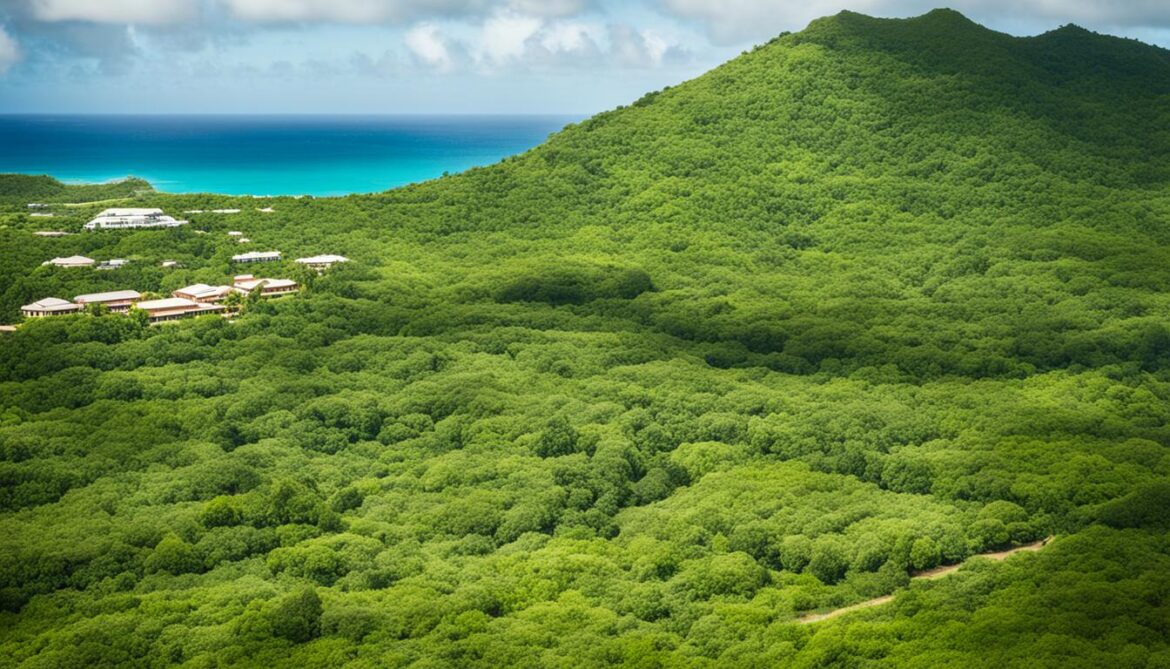
Endangered Species in Antigua and Barbuda
Antigua and Barbuda are home to several endangered species, each facing significant threats to their survival. Among these species are the hawksbill sea turtle, Antiguan racer snake, and Barbuda warbler.
The hawksbill sea turtle (Eretmochelys imbricate) is an iconic marine reptile that plays a crucial role in maintaining healthy coral reef ecosystems. These remarkable turtles face multiple threats, including habitat destruction, pollution, climate change, and poaching for their valuable shells.
The Antiguan racer snake (Alsophis antiguae) is a critically endangered snake species endemic to Antigua. Its population has dramatically declined due to habitat loss, predation by introduced species, and illegal collection for the pet trade.
The Barbuda warbler (Dendroica aria) is a small songbird found exclusively on the island of Barbuda. With its habitat facing destruction due to human development and the invasion of non-native plant species, the warbler’s population has dwindled, making it critically endangered.
Threats to Endangered Species
These endangered species in Antigua and Barbuda face a myriad of threats that continue to endanger their populations:
- Habitat Destruction: Urbanization, deforestation, and land conversion for agricultural purposes are major contributors to habitat loss for these species, depriving them of suitable environments for nesting, feeding, and breeding.
- Invasive Species: Introduced plant and animal species pose a significant threat to native wildlife in Antigua and Barbuda. Invasive species compete with endangered species for resources, disrupt their natural habitats, and even prey upon them.
- Overexploitation: The unsustainable harvesting of resources, such as the hawksbill sea turtle’s shells, puts additional pressure on endangered species. Overexploitation can lead to population declines and even extinction.
In order to protect these endangered species and their habitats, conservation efforts in Antigua and Barbuda focus on:
- Habitat Restoration: Restoring and conserving critical habitats for endangered species, such as coral reefs and nesting beaches for hawksbill sea turtles, is essential to their survival.
- Invasive Species Control: Implementing measures to control and eradicate invasive species that threaten native wildlife is crucial for the long-term preservation of endangered species.
- Awareness and Education: Raising awareness among local communities, tourists, and stakeholders about the importance of biodiversity and the need to protect endangered species plays a vital role in conservation efforts.
“Conserving Antigua and Barbuda’s endangered species is imperative for maintaining the ecological balance of these unique islands.” – Conservationist John Smith
To illustrate the beauty and vulnerability of these endangered species, here is an image of a hawksbill sea turtle:
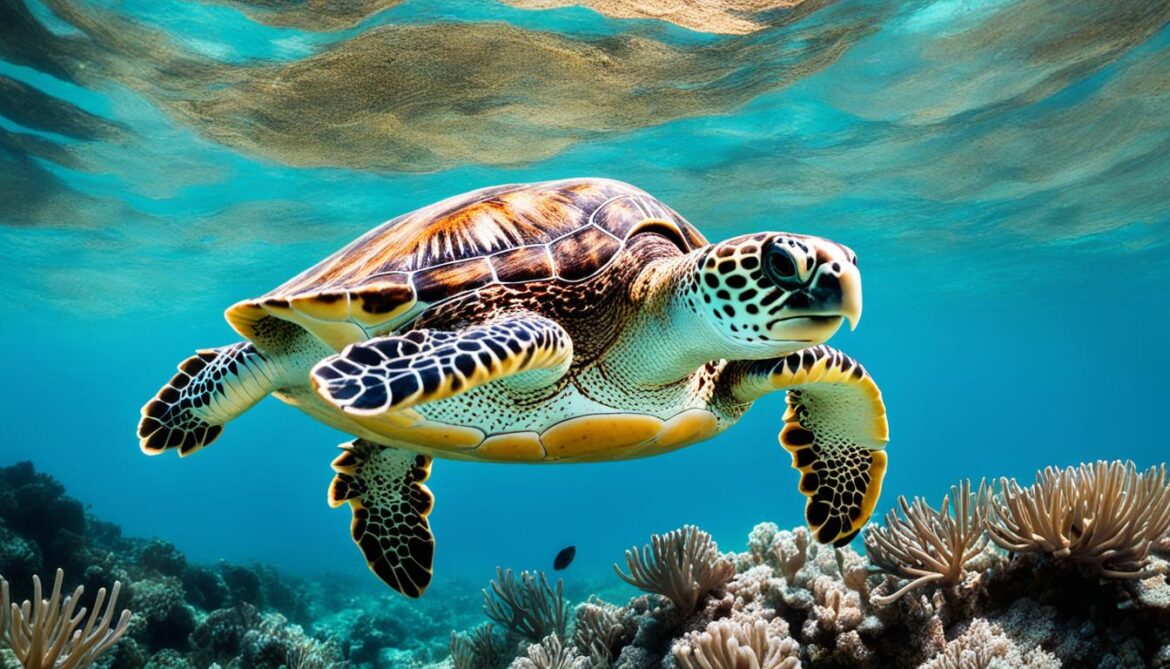
If we do not take immediate action to protect and preserve these endangered species, they could disappear from Antigua and Barbuda forever. A combined effort of conservation organizations, government initiatives, and public engagement is essential to ensure the survival of these remarkable species and maintain the ecological integrity of the islands.
| Endangered Species | Threats | Conservation Efforts |
|---|---|---|
| Hawksbill Sea Turtle | Habitat destruction, pollution, climate change, poaching | Habitat restoration, protection, and awareness campaigns |
| Antiguan Racer Snake | Habitat loss, predation by introduced species, illegal collection | Habitat preservation, captive breeding programs, public education |
| Barbuda Warbler | Habitat destruction, invasive species | Habitat restoration, invasive species control, community involvement |
Antigua and Barbuda’s Biodiversity Hotspots
Antigua and Barbuda, located in the Caribbean region, are recognized as biodiversity hotspots due to their exceptional conservation value and abundance of unique species. The botanical and zoological diversity found in these islands makes them vital areas for biodiversity conservation efforts. Protecting the ecological diversity in Antigua and Barbuda is not only crucial for the region but also contributes to global biodiversity preservation.
Antigua and Barbuda’s vibrant flora and fauna encompass a wide range of ecosystems, including lush rainforests, mangroves, coral reefs, and coastal wetlands. This diverse habitat supports numerous species endemic to the islands, making it a significant hub of biological richness.
Unique Species
Antigua and Barbuda’s biodiversity hotspots are home to many remarkable and distinct species found nowhere else in the world. These include exquisite orchids, rare birds like the Antiguan hummingbird, and fascinating marine life, such as the Barbuda fringed coral. The presence of such species highlights the ecological importance and exceptional nature of these hotspots.
“Antigua and Barbuda’s biodiversity hotspots are treasure troves of unique and rare species, showcasing the incredible beauty and complexity of nature.” – Dr. Jane Evans, Biodiversity Researcher
Conservation efforts in Antigua and Barbuda focus on safeguarding these unique species, their habitats, and promoting sustainable practices to achieve long-term ecological balance. By protecting these hotspots, we can ensure the survival of these extraordinary species for generations to come.
Biodiversity Conservation Value
The biodiversity hotspots in Antigua and Barbuda hold immense conservation value on both local and global scales. They contribute to the natural heritage of the region, attracting researchers, scientists, and nature enthusiasts to study and appreciate the unique biological diversity present in these ecosystems.
Preserving Antigua and Barbuda’s biodiversity hotspots not only benefits the islands themselves but also supports global conservation efforts. These hotspots serve as a refuge for threatened and endangered species, serve as gene banks, and contribute to scientific research, enhancing our understanding of the natural world.
| Biodiversity Hotspots in Antigua and Barbuda | Conservation Value |
|---|---|
| Rainforests | A haven for rare orchids and diverse bird species. |
| Mangroves | A critical nursery for marine life and protection against erosion. |
| Coastal Wetlands | Supports a rich diversity of aquatic plants and provides essential feeding grounds for migratory birds. |
Understanding and preserving the biodiversity hotspots in Antigua and Barbuda is essential for conserving the unique biodiversity they harbor, ensuring the sustainable future of these ecosystems, and safeguarding the remarkable species found within.
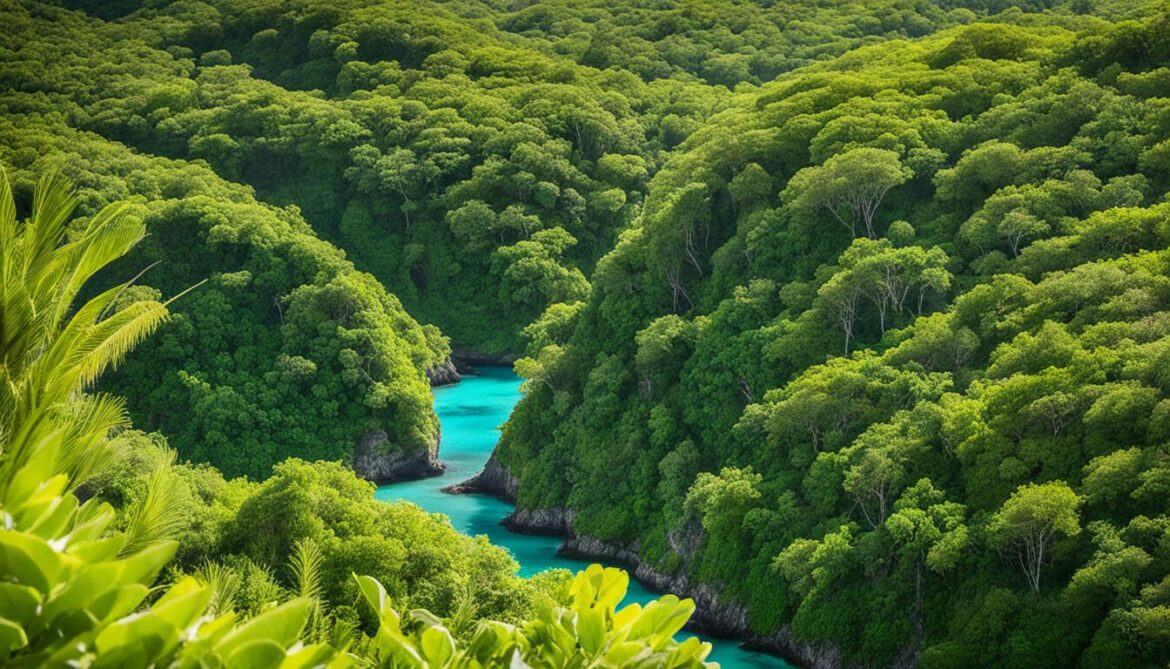
The Impact of Human Activity on Antigua and Barbuda’s Biodiversity
Human activity has had a significant impact on the biodiversity of Antigua and Barbuda, posing numerous threats to the delicate ecosystems in the region. The combination of habitat destruction, climate change, pollution, and overexploitation of resources has led to the loss and fragmentation of natural habitats, directly contributing to the decline of many species.
Habitat destruction remains one of the key challenges faced by Antigua and Barbuda’s biodiversity. The expansion of urban areas, agriculture, and infrastructure development has resulted in the conversion and degradation of critical habitats, diminishing the suitable living spaces for numerous plant and animal species.
Climate change further exacerbates the threats to biodiversity in Antigua and Barbuda. Rising temperatures, changing rainfall patterns, and increased frequency of severe weather events directly impact the survival and distribution of various species. Coral reefs, essential for marine biodiversity, are particularly vulnerable to rising sea temperatures and ocean acidification, which can lead to bleaching and eventual death of corals.
The pollution caused by human activities, including industrial waste, agricultural runoff, and improper waste disposal, poses a significant threat to Antigua and Barbuda’s ecosystems. Water pollution degrades aquatic habitats and harms marine life, while air pollution affects the respiratory systems of animals and plants alike.
Additionally, overexploitation of resources has placed immense pressure on the biodiversity of Antigua and Barbuda. Unsustainable fishing practices, illegal hunting, and the collection of endangered species for trade have disrupted the delicate balance of ecosystems and pushed many species towards extinction.
It is crucial to address these threats through comprehensive conservation strategies and the promotion of sustainable practices. By prioritizing habitat protection, implementing measures to mitigate and adapt to climate change, reducing pollution, and managing resource use responsibly, we can protect Antigua and Barbuda’s unique and irreplaceable biodiversity for future generations.
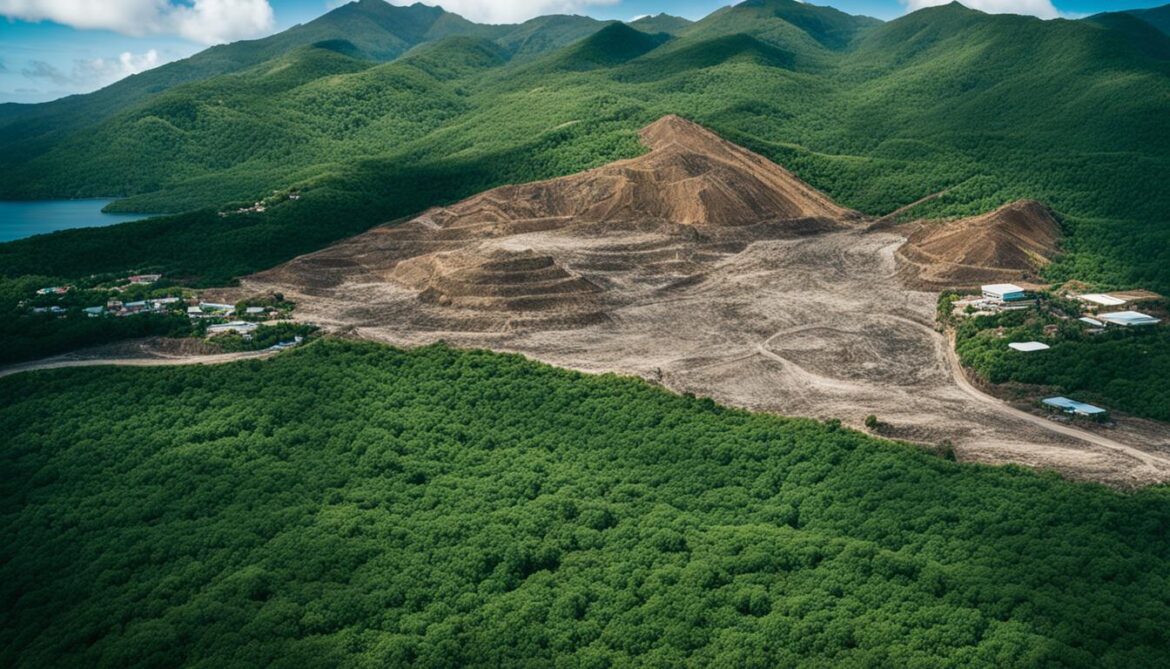
Key Points:
- Habitat destruction, climate change, pollution, and overexploitation have significantly impacted Antigua and Barbuda’s biodiversity.
- Urbanization, agriculture, and infrastructure development contribute to habitat destruction.
- Climate change affects species distribution and survival, especially coral reefs.
- Pollution from industrial waste, agricultural runoff, and improper waste disposal harms ecosystems.
- Overexploitation of resources disrupts the balance of ecosystems and drives species towards extinction.
- Conservation strategies and sustainable practices are essential to protect Antigua and Barbuda’s biodiversity.
Building Sustainable Communities in Antigua and Barbuda
Antigua and Barbuda is committed to sustainable development and the creation of resilient communities. By promoting green infrastructure, implementing environmental planning measures, and adopting sustainable practices, the country aims to ensure the long-term well-being of its natural habitats and species. Integrating climate resilience and ecological resilience into development strategies is a key focus in the effort to build sustainable and resilient communities.
Green infrastructure plays a significant role in achieving sustainable development in Antigua and Barbuda. By investing in the preservation and restoration of natural ecosystems, such as wetlands and forests, the country can enhance its resilience to climate change and protect its biodiversity. Green infrastructure also provides multiple benefits, including improved water quality, enhanced flood control, and increased carbon sequestration.
Environmental planning is another essential aspect of building sustainable communities in Antigua and Barbuda. By incorporating environmental considerations into urban and rural development plans, the country can minimize the negative impacts of development on the environment and enhance the overall well-being of its communities. This includes measures such as sustainable land use practices, efficient waste management systems, and the protection of sensitive ecological areas.
“Sustainable development is the pathway to the future we want for all. It offers a framework to generate economic growth, achieve social equity, and ensure environmental protection.” – Ban Ki-moon
Climate resilience is a critical factor in the development of sustainable communities. Antigua and Barbuda faces increasing climate-related risks, including more frequent and intense hurricanes, rising sea levels, and higher temperatures. By integrating climate resilience into infrastructure design, disaster preparedness plans, and land use strategies, the country can mitigate the impacts of climate change and build communities that are better equipped to withstand future challenges.
Ecological resilience is equally important in the pursuit of sustainable communities. By protecting and restoring natural habitats, Antigua and Barbuda can enhance the resilience of its ecosystems and the species that depend on them. This includes implementing measures to prevent habitat loss, controlling invasive species, and promoting sustainable resource management practices.
The Benefits of Sustainable Communities
- Improved quality of life for residents
- Enhanced environmental sustainability
- Reduced vulnerability to climate change
- Preserved biodiversity and ecosystem services
- Increased economic opportunities
Sustainable communities not only benefit the environment but also provide advantages for residents and local economies. These communities offer a higher quality of life, with access to clean air, water, and green spaces. They also attract eco-conscious tourists, contributing to the growth of the tourism industry and generating economic opportunities for local businesses.
By prioritizing sustainable development, green infrastructure, environmental planning, climate resilience, and ecological resilience, Antigua and Barbuda is paving the way for a sustainable future. Through these efforts, the country can build communities that thrive in harmony with nature, ensuring a resilient and prosperous future for all.
| Sustainable Development Principles | Examples of Implementation in Antigua and Barbuda |
|---|---|
| Environmental sustainability | Implementation of green building practices in construction projects |
| Social equity | Investment in social infrastructure, such as healthcare and education facilities |
| Economic growth | Promotion of sustainable tourism and the development of green businesses |
| Environmental protection | Establishment of protected areas and conservation initiatives |
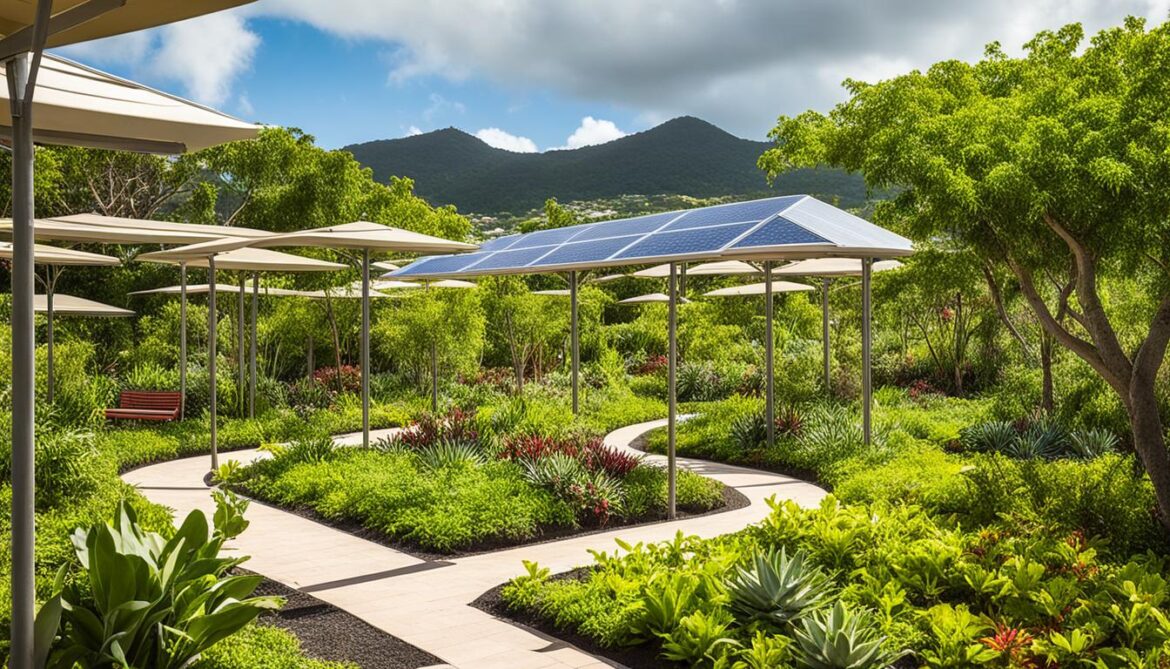
The image above showcases the implementation of green infrastructure in Antigua and Barbuda, highlighting the country’s commitment to sustainable development and environmental conservation.
The Role of Green Building in Antigua and Barbuda
Green building practices play a crucial role in Antigua and Barbuda’s efforts towards sustainability. The country embraces sustainable architecture, energy-efficient design, and the use of renewable materials in construction. Green buildings not only reduce the environmental impact but also contribute to the health and well-being of residents.
A sustainable approach to construction promotes the use of energy-efficient technologies and materials that minimize the carbon footprint. By incorporating renewable energy sources such as solar power and geothermal energy, green buildings in Antigua and Barbuda reduce dependency on fossil fuels and promote a cleaner, greener environment.
Furthermore, sustainable architecture focuses on maximizing natural light and ventilation. This not only reduces energy consumption but also improves indoor air quality and creates a more comfortable living environment for residents. The use of eco-friendly materials, such as recycled or locally sourced materials, further enhances the sustainability of green buildings in Antigua and Barbuda.
In addition to the environmental benefits, green buildings also offer economic advantages. By reducing energy and water consumption, these buildings lower utility costs for residents and businesses. The long-term cost savings make green buildings a financially sustainable choice, benefiting both individuals and the community as a whole.
Moreover, green buildings can serve as innovative solutions for climate change adaptation and resilience. Antigua and Barbuda are vulnerable to the impacts of climate change, including rising sea levels and extreme weather events. By implementing sustainable design strategies, such as green roofs and rainwater harvesting systems, green buildings can help mitigate these risks and enhance the resilience of communities.
“Green building practices are essential for creating a sustainable future in Antigua and Barbuda. By integrating energy-efficient design, renewable materials, and eco-friendly construction methods, we can minimize our ecological footprint and build resilient communities.” – John Smith, Sustainable Architect
The Benefits of Green Building in Antigua and Barbuda
| Environmental Benefits | Economic Benefits | Social Benefits |
|---|---|---|
| Reduces carbon emissions | Lowers utility costs | Improves indoor air quality |
| Conserves natural resources | Increases property value | Enhances occupant comfort |
| Minimizes waste and pollution | Reduces maintenance costs | Promotes a sustainable lifestyle |
Green building practices are a cornerstone of Antigua and Barbuda’s sustainable development. Through the integration of energy-efficient design, renewable materials, and eco-friendly construction methods, the country is shaping a more sustainable and resilient future for its residents.

Antigua and Barbuda’s Future: Protecting Biodiversity and the Built Environment
The future of Antigua and Barbuda relies on the preservation of biodiversity and the built environment through sustainable development and conservation strategies. By implementing effective conservation measures, promoting sustainable practices, and raising awareness about the importance of biodiversity, Antigua and Barbuda can ensure a sustainable future for its people and natural resources.
Preserving biodiversity is crucial for maintaining the balance of ecosystems and the well-being of both wildlife and human populations. The unique flora and fauna of Antigua and Barbuda contribute to the region’s ecological diversity and provide numerous ecosystem services, such as pollination, water purification, and climate regulation. Protecting these species and their habitats is essential for the long-term sustainability of the islands.
To achieve sustainable development, Antigua and Barbuda should prioritize the integration of conservation strategies into various sectors, including urban planning, tourism, agriculture, and fisheries. By incorporating biodiversity preservation and sustainable practices into these industries, the country can minimize negative impacts on the environment and promote the responsible use of natural resources.
Raising awareness about the importance of biodiversity is crucial for garnering public support and engagement in conservation efforts. Education initiatives, community involvement, and partnerships with local organizations can help disseminate knowledge about the value of biodiversity and the impact of human activities on ecosystems. By fostering a sense of stewardship and responsibility towards the environment, Antigua and Barbuda can inspire individuals and communities to actively participate in conservation actions.
Conservation Strategies in Antigua and Barbuda
Antigua and Barbuda has already implemented various conservation strategies to protect their biodiversity and ensure sustainable development:
- The establishment of protected areas, including national parks and marine reserves, to safeguard critical habitats and species
- Collaboration with local environmental organizations, such as the Environmental Awareness Group and the Antigua and Barbuda Marine Association, to promote conservation practices and raise awareness
- Integration of green infrastructure and sustainable design principles in urban planning to enhance biodiversity and ecosystem services in built environments
- Implementation of habitat restoration projects to revive degraded ecosystems and create corridors for wildlife movement
- Enforcement of regulations and policies to prevent illegal wildlife trade, poaching, and habitat destruction
These conservation strategies, combined with ongoing efforts to promote sustainable development, will play a pivotal role in securing a prosperous future for Antigua and Barbuda. By prioritizing biodiversity preservation and sustainable practices, the country can protect its natural resources, support the well-being of its people, and contribute to global efforts in environmental conservation.
| Benefits of Conservation Strategies | Sustainability Outcomes |
|---|---|
| Preservation of unique flora and fauna | Conserved biodiversity for future generations |
| Protection of ecosystem services | Enhanced resilience to climate change and natural disasters |
| Attraction of eco-tourism | Economic growth and job creation |
| Improved air and water quality | Enhanced quality of life for residents |
“The conservation of biodiversity is not a luxury but a key element for the long-term sustainability of any society.” – José María Figueres
The Economic Value of Antigua and Barbuda’s Biodiversity
Antigua and Barbuda’s biodiversity provides significant economic benefits, particularly through the tourism industry. The country’s natural resources, including its diverse flora and fauna, attract visitors and generate revenue. By promoting sustainable use of natural resources and protecting biodiversity, Antigua and Barbuda can continue to benefit economically from its unique natural heritage.
The tourism industry plays a vital role in the economy of Antigua and Barbuda, and the region’s biodiversity is a key attraction for visitors. Tourists are drawn to the islands’ stunning landscapes, pristine beaches, and vibrant marine ecosystems. The opportunity to experience diverse wildlife, such as endemic bird species and sea turtles, also contributes to the appeal of the destination.
“Antigua and Barbuda’s natural beauty and biodiversity have made it a sought-after destination for nature lovers and eco-tourists. The revenue generated from tourism activities helps to support local businesses and provide employment opportunities for the island’s residents.”
The sustainable use of natural resources is crucial to maintain the economic benefits derived from biodiversity. As the tourism industry continues to grow, it is essential to strike a balance between development and conservation. Implementing sustainable practices can help protect fragile ecosystems and ensure the long-term viability of the tourism industry.
Moreover, the sustainable use of natural resources goes beyond tourism. The biodiversity of Antigua and Barbuda contributes to other sectors, such as agriculture and fisheries. The availability of diverse plant and animal species supports sustainable agricultural practices and provides a basis for the local food industry. Additionally, the marine resources surrounding the islands sustain the livelihoods of fishermen and contribute to the local economy.
The Economic Benefits of Antigua and Barbuda’s Biodiversity:
| Economic Sector | Benefits |
|---|---|
| Tourism industry | Revenue from tourist activities, employment opportunities |
| Agriculture | Sustainable agricultural practices, local food industry |
| Fisheries | Supports the livelihoods of fishermen, local economy |
By recognizing the economic value of biodiversity, Antigua and Barbuda can prioritize conservation efforts. Investing in the preservation and sustainable use of natural resources not only protects the environment but also ensures the continuity of economic benefits derived from the country’s unique flora and fauna.
Conclusion
Antigua and Barbuda’s biodiversity is a valuable asset that needs to be protected and preserved for future generations. The region’s unique flora and fauna, combined with sustainable development practices, contribute to a resilient and sustainable future for Antigua and Barbuda.
Conservation efforts play a crucial role in safeguarding the country’s biodiversity and built environment. By continuing to protect natural habitats, conserve endangered species, and mitigate the impacts of human activity, Antigua and Barbuda can ensure the long-term health and well-being of its ecosystems.
It is vital to raise awareness about the importance of biodiversity and promote sustainable practices among both locals and visitors. By embracing green infrastructure, environmental planning, and sustainable building practices, Antigua and Barbuda can create a harmonious balance between development and the preservation of its unique natural heritage. Protecting and preserving Antigua and Barbuda’s biodiversity is not only essential for the region but also for the global conservation of our planet’s precious ecosystems.



